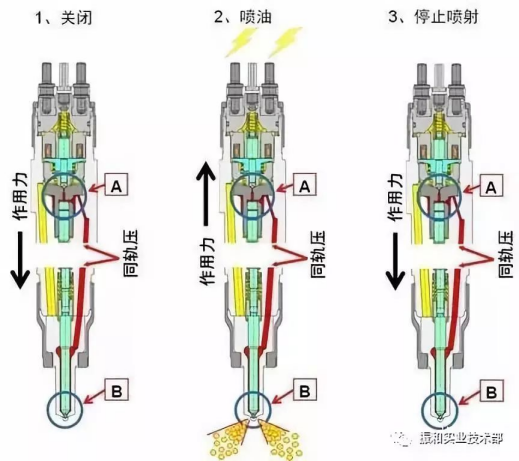Injector
The injector is manufactured by Bosch and is sealed as a unit. DEUTZ does not provide internal components. The injector consists of an injector housing similar to a conventional injector holder, a nozzle with multiple holes, a valve housing with two openings to adjust the pressure in the control chamber and a corresponding control piston, an armature device with a small ball to open and close the throttle hole, and the solenoid valve (coil) and the electrical connection of the ECU.
The injector control structure is a small control valve with hydraulic balance. The lifting needle is operated by adjusting the pressure difference between the seat (low end) and the upper part of the lifting needle. A small solenoid control valve installed on the lifting needle is used to control the solenoid valve to adjust the pressure on the upper part of the lifting needle.
The injection pressure is determined by the rail pressure and can vary between 300 bar (at idle) and 1600 bar. This pressure continuously acts on the lifting area of the injector lifting needle.
The injector is manufactured by Bosch and is sealed as a unit. DEUTZ does not provide internal components. The injector consists of an injector housing similar to a conventional injector frame, a nozzle with multiple holes, a housing with two opening valves for regulating the pressure in the control chamber and a corresponding control piston, an armature device with a small ball to open and close the throttle hole, and the electrical connection between the solenoid valve (coil) and the ECU.
The injector control structure has a small control valve with hydraulic balance. The lifting needle is operated by adjusting the pressure difference between the seat (low end) and the upper part of the lifting needle. A small electromagnetic control valve installed on the lifting needle is used to control the solenoid valve to adjust the pressure on the upper part of the lifting needle.
The injection pressure is determined by the oil rail pressure and can vary between 300 bar (at idle) and 1600 bar. This pressure continuously acts on the lifting area of the injector lifting needle.
1. Static closing stage: The electromagnet is not energized, and the valve ball tightly seals the valve seat surface under the action of the spring force. Since the fuel entering chamber A has the same pressure as the fuel entering chamber B (common rail), and the hydraulic force area of the valve stem end face is much larger than the hydraulic force area of the needle valve end, the combined force acting on the entire moving part is downward. At this time, the needle valve is seated and tightly seals the spray hole, and no fuel is sprayed.
2. Injection stage: When the electromagnet is energized, an upward electromagnetic force is generated. At this time, the electromagnetic force attracts the armature disc to move upward, and the ball valve is pushed open under the action of high-pressure fuel. The high-pressure fuel in chamber A quickly returns to the oil through the seat hole, and the oil pressure in chamber A drops sharply. However, the fuel in chamber B at the needle valve end still maintains a pressure close to the rail pressure, so the combined force acting on the entire moving part is upward, forcing the needle valve to lift, and the high-pressure fuel is sprayed into the combustion chamber through the spray hole to achieve injection. When the solenoid valve is continuously energized, the injector continues to spray fuel.
3. Stop injection: Once the electromagnet stops energizing, the electromagnetic force it generates disappears immediately, and the armature core forces the ball valve to tightly seal the valve seat surface under the action of the spring force. At this time, the oil pressure in chamber A increases rapidly until it approaches the oil pressure in the oil rail. The combined force acting on the entire moving part turns downward, the needle valve seats and tightly seals the spray hole, and the oil spray stops.
Since the injection timing of the hydraulic servo injector is completely dependent on the oil pressure change in each control chamber, there is a certain hydraulic delay from the electromagnet being energized to the start of injection. The wear condition of the guide surface of each moving part will affect the length of the hydraulic delay. Generally, the more severe the wear, the greater the injection delay, as shown in the following figure:

Contaminated fuel Water, foreign particles
The most sensitive part is the injector. If the nozzles are worn/cavitated, they will continue to leak because the rail pressure always acts on the needle valve.
Worn filling and discharge openings of the needle valve return chamber affect the opening function of the needle valve and the injection time.
The high-pressure fuel pump is also sensitive to particles and water in the fuel. They deliver three times the amount of fuel as a Stage II engine, so if the fuel is contaminated, they will wear quickly. The I/O-valves of the high-pressure fuel pump are most sensitive to dust particles.
Due to contaminated diesel, the FCU valves can also get stuck. When the FCU solenoid valve gets stuck, the rail pressure becomes abnormal, and the 208, 236, 244 rail pressure related fault codes appear in the serdia. The engine reacts by automatically shutting down after starting.
#deutz #cummins #caterpillar #bosch #Perkins
Drop us an email, let’s discuss more details
Copyright © Shijiazhuang Hovor Diesel Engine Co., Ltd. All Rights Reserved | Sitemap | Technical Support: 